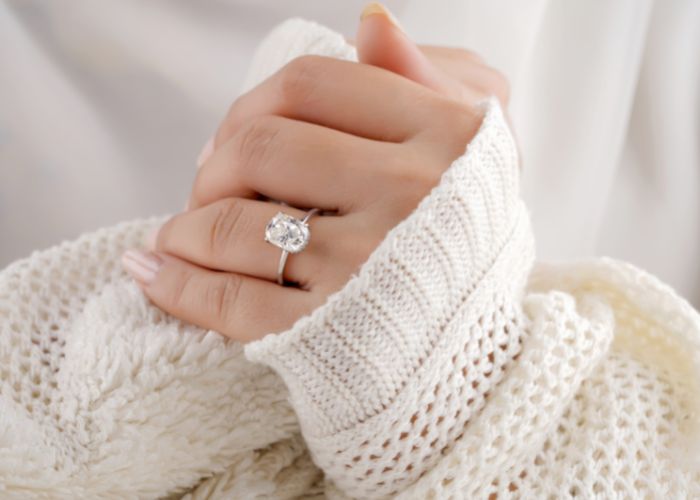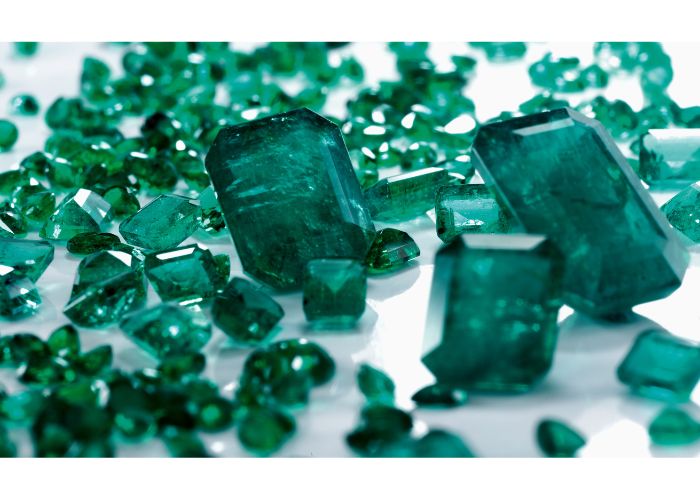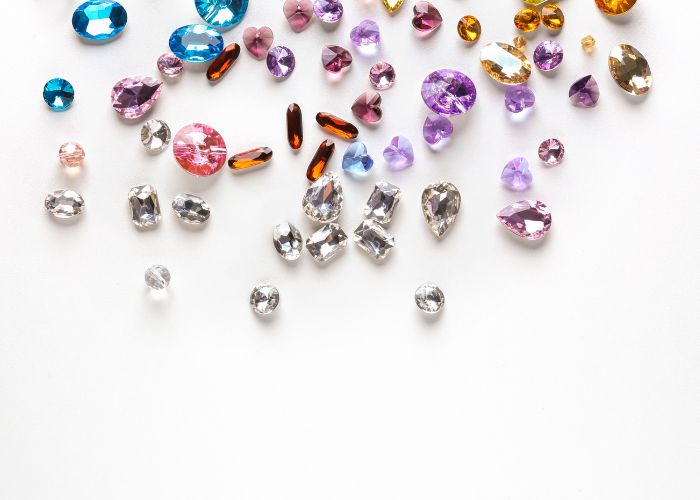Hey There! We may earn a commission from links on this page. This helps support the site and is at no extra cost to you. Thanks!
Are you wondering how to identify precious stones in jewelry? Learn how to identify the most common stones.
When shopping for fine antique and vintage jewelry it is important to be able to identify precious stones. Whether you are looking for white diamonds, fancy diamonds, sapphires, rubies, or emeralds, this is the guide for you.
Diamonds
For centuries people all over the world have coveted diamonds. These precious gemstones were traded in India, during the fourth century BCE. Formed deep in the earth’s crust, diamonds require extreme heat and pressure to form, eventually moving upward toward the earth’s crust.
When India’s diamond mines were emptied, large deposits were found in Brazil, in the 1700s. The country would dominate the trade for the next 150 years.
Diamonds are most often associated with diamond engagement rings, thanks to Tiffany & Co., headquartered in New York. In 1886, they developed the six-prong diamond solitaire engagement ring, allowing light under the stone. This helped to create an even more vivid sparkle.

A couple of decades later, in the late 1800s, diamonds became more affordable with the founding of De Beers Consolidated Mines Ltd., using diamonds newly discovered in South Africa.
During the Edwardian period from 1901-1914, white on white jewelry was popular, and featured white gold or platinum jewelry, set with diamonds or pearls. Interesting cuts of diamonds displayed simultaneously were crafted into fine pieces. Think old mine cut, old European cut, rose cut and marquise cut. Then, there is the octagonal shaped Asscher cut, with 74 facets.
With the discovery of diamonds in Australia, in 1985 and in Canada, in 2000, the market expanded further.
The Value of A Diamond & Fancy Diamonds
The diamonds that are most valued are ones with no color. These are graded from A to Z, with diamonds containing more brown or yellow, at the lowest part of the scale. However, diamonds are more complex. Anything beyond the Z grade will have so much color that it is valued as a rare and fancy grade diamond. The highly saturated colored diamond come in yellow, pink, green and even blue.
Read our articles about colored diamonds.
How to Identify Diamond Jewelry
Diamonds can bend light, which leads to their radiant sparkle. This sparkle is known as a diamond’s radiance. Other stones, such as cubic zirconia will not have the radiance of a diamond.
[Read: Lab-grown Diamonds Vs Moissanite and Cubic Zirconia: What You Need to Know]
The fog test is an uncomplicated way to tell if a diamond is real. Simply breathe on it. The diamond will clear the fog in seconds.
When buying fine antique or vintage jewelry with a diamond the setting is key. This precious stone will be set in gold or platinum. Look for the marks that ensure the ring is real gold, whether it is yellow gold, rose gold or white gold.
When looking at antique pieces, keep in mind that rose gold was not invented until famed Russian jeweler Carl Fabergé (1846-1920) introduced it to the Russian court in the late 1800s. It became popular in North America in the 1920s. White gold was not available until the 1900s.
There is an exception to the above rules, when ensuring your diamond is real by accessing the precious metal it is crafted in. Gold jewelry may not have any marks at all. This wasn’t required by law until the 1900s. In this case, be sure to consult an expert.
[Read: Costume Jewelry Designers that use Real Gold]
Additionally, with the invention of the oxyacetylene torch, jewelers were able to work at high enough temperatures, to craft in pure platinum. This did not occur until 1903. Look for the purity marks to show it is platinum such as 585, 700, 900 and 950. Also look for the letters PT and Plat to indicate it’s platinum.
[Read: Platinum vs. White Gold in Vintage Jewelry]
It is important to note, if you see the letters CZ stamped into a piece of diamond jewelry, it is a clear indication you are looking at a cubic zirconia. This is not a diamond.
Watch 5 Ways to tell if your Diamond is Real or Fake:
Rubies
The ruby, the lucky birthstone for those born in July, was discovered in Myanmar (Burma) starting in 2500 BC. The fiery red precious stone is associated with both passion and vibrancy. The ruby is the rarest stone between the main three precious-colored stones: rubies, sapphires, and emeralds.
Historically, the word ruby was used to describe any red stone, including spinel and garnet, up until the late 1800s.
[Read: Buyers Guide to Vintage Ruby Engagement Rings]
Of the corundum minerals the ruby is one of the species along with the sapphire. When corundum is red, it is a ruby. Nationally clear corundum takes on color when mixed with other trace elements. Chromium is what turns a ruby red. The colour tone of a red ruby can range from an orange red to a red purple.

Actress Elizabeth Taylor was renowned for her jewelry collection and the men who gave it to her as gifts. For Christmas, in 1968 actor Richard Burton surprised her with a stocking stuffer. It was a custom designed ring from Van Cleef & Arpels featuring an 8.24 oval cut, pigeon’s blood ruby, from Burma, crafted into a ring of gold, surrounded by diamonds. It was auctioned after her death for $4 million dollars.
Pigeon’s blood is a term used to describe the color. It is said to have originated in Burma and refers to the color of the first two drops of blood from a pigeon’s nose. It is a perfect ruby red.
Rubies are mined in Asia, Australia, Africa, South America, and the United States.
How to Identify Rubies in Jewelry
Rubies are created through the pressure of the earth, and as such they incur natural inclusions. These inclusions ensure a ruby is not naturally translucent.
Hold jewelry with rubies up under a flashlight. Take a close look and use a jeweler’s loop if you have one. If it is perfectly clear and flawless, it is best to assume it is a fake glass stone.
Rubies will also glow under a UV light. If you have a UV flashlight, this is a quick way to identify a ruby.
Watch How to Identify a Ruby:
Sapphires
The word sapphire comes from the Greek word sapphiros. This September birthstone has always been associated with truth, sincerity, nobility, and faithfulness. This may be why sapphires make perfect stones in engagement rings.
[Read: Vintage Sapphire Engagement Rings Buying Guide]
In 1981, Prince Charles presented his bride to be, the fair Lady Diana Spencer, with a 12-carat sapphire ring surrounded by diamonds. Later Prince William gave the same ring as an engagement gift to Kate Middleton.
Within the jewelry business, a sapphire usually means a blue stone. The Kashmir sapphire in a velvet blue set the standard. Although blue sapphires are the most popular color of these precious gemstones, you will also find sapphires in a range of colors including “fancy sapphires” pink, purple, violet, yellow, green, and orange. Some are even gray, black, or brown.
The orange pink sapphire from Sri Lanka is called a padparadscha, which means lotus flower in the Sinhalese language. It is a precious gemstone that the country is particularly proud of.
Sapphires are also mined in Myanmar, Australia, Madagascar, and Tanzania.
How to Identify Sapphires in Jewelry
When identifying a sapphire in antique or vintage jewelry, look at the color. Do not be afraid to hold it under bright light. Regardless of what color the sapphire is-- the more saturated the better!
Additionally, the light the sapphire reflects should be the color of the gemstone. If other colors flash through it, then it is not a sapphire.
A natural sapphire will always have inclusions. These occur in the form of color zoning with bands of alternating color, and halos around liquid inclusion. You may notice other small minerals inside including specs of zircon, mica, hematite, spinal and calcite. However, inclusions do not include air bubbles. This is a sign of a fake glass stone.
Watch How to Tell if a Sapphire is Real or Fake:
Some real sapphire jewelry on the market has been filled with lead to increase the color and to pass it off as a more superior stone. Sapphires filled with lead indicate a poor-quality stone. You will see lines in the sapphire that indicate lead filling.
Try the breath test on a sapphire. Simply breathe on it. Sapphires can easily conduct heat, which means a real one can clear fog in seconds. A fake glass stone will stay foggy longer.
[Read: How to Buy Sapphire Jewelry Online]
Emeralds

Emeralds are a variety of beryl. Only beryl with enough green in them are referred to as emeralds. Anything too light is called a green beryl.
The ancient Greek word smaragos means green gem and provides the history of the emerald’s name. This birthstone for the month of May has always been associated with magical powers.
Emeralds were first mined in ancient Egypt back in 1500 BCE. So valued were green emeralds, that they were buried with the dead. Emeralds were revered in South America, and the famed Crown of the Andes, used in ceremonies to adorn the sculpture of the Virgin of the Immaculate Conception in Papayan, Columbia, has over 400 emeralds. Pieces of the golden crown, which were crafted beginning in 1770, also hold the famous 24 carat Atahualpha emerald.
[Read: How to Buy Emerald Jewelry Online]
How to Identify Emeralds in Jewelry
Emeralds contain a lot of natural inclusions or flaws, which make each unique and beautiful. These appear as little threads, with tiny bubbles around them. Since emeralds are highly transparent this will be easily visible to the naked eye. If the bubbles are not surrounding the threads, or if the stone does not include any inclusions, the stone is a fake.
Watch How to Tell if an Emerald is Real or Fake:
An emerald’s color is important. The color that is valued the most is blue green to pure green, yet not too dark. The color will be even across the stone. When held up to the light it should maintain its be green or blue green. Any yellow or brown indicate it is not a precious emerald gemstone. Also, if it radiates a sparkle of rainbow hued colors, it is fake.
Where to Buy Authentic Jewelry
For antique and vintage jewelry with precious stones, search reputable vendors online through Etsy and eBay.
[Read: The Best eBay Shops for Buying Fine Vintage Jewelry]
[Read: The Best Vintage Jewelry Shops on Etsy]
Conclusion
Antique and vintage jewelry crafted with precious stones is worth collecting. The quality ensures the value and durability of the pieces for years to come.

